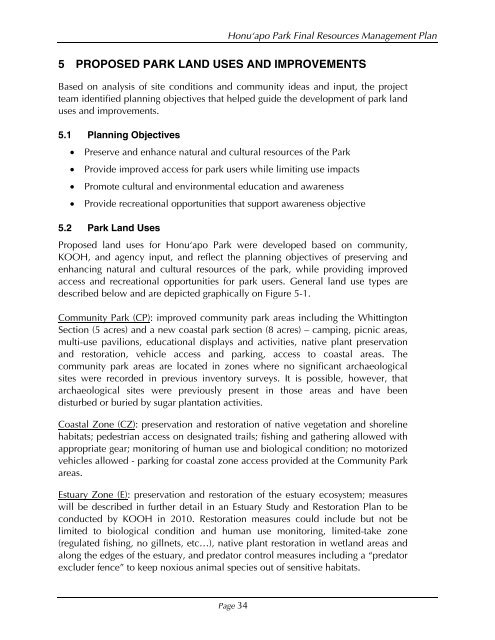Honu'apo Park Resource Management Plan
Honu'apo Park Resource Management Plan
Honu'apo Park Resource Management Plan
You also want an ePaper? Increase the reach of your titles
YUMPU automatically turns print PDFs into web optimized ePapers that Google loves.
Honuÿapo <strong>Park</strong> Final <strong>Resource</strong>s <strong>Management</strong> <strong>Plan</strong><br />
5 PROPOSED PARK LAND USES AND IMPROVEMENTS<br />
Based on analysis of site conditions and community ideas and input, the project<br />
team identified planning objectives that helped guide the development of park land<br />
uses and improvements.<br />
5.1 <strong>Plan</strong>ning Objectives<br />
• Preserve and enhance natural and cultural resources of the <strong>Park</strong><br />
• Provide improved access for park users while limiting use impacts<br />
• Promote cultural and environmental education and awareness<br />
• Provide recreational opportunities that support awareness objective<br />
5.2 <strong>Park</strong> Land Uses<br />
Proposed land uses for Honuÿapo <strong>Park</strong> were developed based on community,<br />
KOOH, and agency input, and reflect the planning objectives of preserving and<br />
enhancing natural and cultural resources of the park, while providing improved<br />
access and recreational opportunities for park users. General land use types are<br />
described below and are depicted graphically on Figure 5-1.<br />
Community <strong>Park</strong> (CP): improved community park areas including the Whittington<br />
Section (5 acres) and a new coastal park section (8 acres) – camping, picnic areas,<br />
multi-use pavilions, educational displays and activities, native plant preservation<br />
and restoration, vehicle access and parking, access to coastal areas. The<br />
community park areas are located in zones where no significant archaeological<br />
sites were recorded in previous inventory surveys. It is possible, however, that<br />
archaeological sites were previously present in those areas and have been<br />
disturbed or buried by sugar plantation activities.<br />
Coastal Zone (CZ): preservation and restoration of native vegetation and shoreline<br />
habitats; pedestrian access on designated trails; fishing and gathering allowed with<br />
appropriate gear; monitoring of human use and biological condition; no motorized<br />
vehicles allowed - parking for coastal zone access provided at the Community <strong>Park</strong><br />
areas.<br />
Estuary Zone (E): preservation and restoration of the estuary ecosystem; measures<br />
will be described in further detail in an Estuary Study and Restoration <strong>Plan</strong> to be<br />
conducted by KOOH in 2010. Restoration measures could include but not be<br />
limited to biological condition and human use monitoring, limited-take zone<br />
(regulated fishing, no gillnets, etc…), native plant restoration in wetland areas and<br />
along the edges of the estuary, and predator control measures including a “predator<br />
excluder fence” to keep noxious animal species out of sensitive habitats.<br />
Page 34


